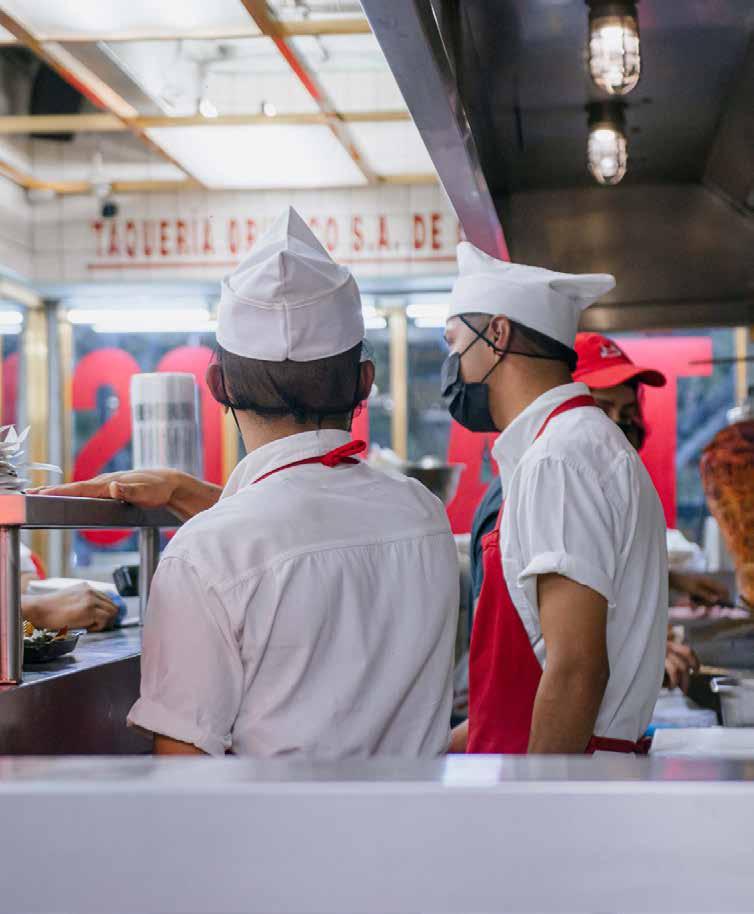
4 minute read
Consulting Corner
The Real Reason You Can’t Retain Workers
The hospitality industry historically suffers from the highest unemployment rate of any industry. The most glaring issues that potential workers see is a lack of career growth, low wages, unpredictable paychecks or hours, and lack of benefits. With a turnover rate of 75 percent and only 10 percent of restaurants reporting being fully staffed; we have to find solutions. And we need to find them now.
Advertisement
In addition to poor working conditions, many employees in the service industry suffer from mental health issues. An industry survey found that 84.8 percent of restaurant managers and kitchen staff report depression, 72.9 percent report anxiety, and 50.1 percent report substance abuse issues. These numbers are staggering compared to most fields, especially when only 8 percent of the nationwide population report substance abuse issues and/or depression. There are many factors that play into these numbers.
One could argue that people who suffer from mental illnesses or drug and alcohol abuse issues are drawn to this field due to its transient nature and high turnover rates. However, the numbers don’t lie. Service employees are thirsty for more support from their workplace. Health insurance, stable hours, fair pay, and an open dialogue about mental health could very well save this industry. During the Great Reshuffling, many workers were drawn to jobs that offered paid time off, personal days, adequate sick, bereavement, or maternity leave, and higher wages.
So how do we compete with the corporate offices or digital platforms for which many workers abandoned the food and beverage industry? There are several ways to navigate this.
HIGHER WAGES AND NEW BUSINESS MODELS. We all know that minimum wage is no longer the industry standard. To compete with chain fast food restaurants, several operations had to raise the bar from minimum wage to a more livable wage. Many owner operators cannot afford to go higher than this. Don’t fret just yet because there are alternatives to raising your wages (again). Perhaps it’s time to reconsider your business model. Henry Patterson, founder and CEO of ReThink Restaurants, trains managers and business owners on open-book management and profit-sharing in the restaurant industry. His unique business model is groundbreaking, creating a whole new way of how we view our workers and our management in the industry. We achieve a level of transparency with our employees that was absent in the past. Using open-book management shows your staff just how much of the restaurant’s success and profitability is impacted by their performance, all while introducing profit-sharing to your team through hands-on financial literacy training. Operations using this model hover around 20 percent profit margins. TAKING CARE OF YOUR TEAM. While the idea of providing health insurance seems to be a nobrainer for retaining staff, it can be a daunting task for business owners. We know that the cost to hire and train a new crew member can set you back roughly $5,000. However, investing a portion of that cost on your current staff members’ health insurance policies creates a world of difference in morale. If this is still out of reach for you, try out a performance-based incentive first, like accruing PTO based on the number of hours worked or setting up healthcare benefits that kick in once a staff member has reached their one-year anniversary.
MENTAL HEALTH: LET’S TALK ABOUT IT. If you walk into any kitchen in America and ask the line cooks if they’re burnt out, odds are at least one of them will raise their hand. Many operations are struggling to adequately staff their restaurant or bar, so the brunt of open shifts fall on management or senior employees who are devoted to your company. A round of applause for those hard workers is much appreciated but does nothing to fix this issue. At the end of the day, they are still overworked, historically underpaid, and letting out their anger in the soundproof confines of your walk-in cooler. In 2016, the Center for Disease Control and Prevention listed chefs and food service workers as one of the top 20 professions with the highest suicide rates. So, how do we help? There are many non-profit programs that offer free online group sessions on mental health advocacy and how to ask for help. Give resources to your staff. If you personally don’t struggle with these issues, attending group therapy sessions specifically designed for industry workers could give you some insight into the problems they are facing today. Take these tools with you and create an open dialogue about mental health in the workplace.
We are all working towards a common goal: a profitable, sustainable, and supportive workplace. There are many approaches to the problems we are facing today. The key is finding the best solutions for you and your staff, whether it be a new business model, a different tipping structure, or offering more benefits and health resources to your staff. With time, we will begin to see the unemployment rate fall exponentially if we use these tools. The workforce is hungry for solutions to their problems, and it is time
we listen. KATE RATLEDGE, TOGATHER RESTAURANT CONSULTING









